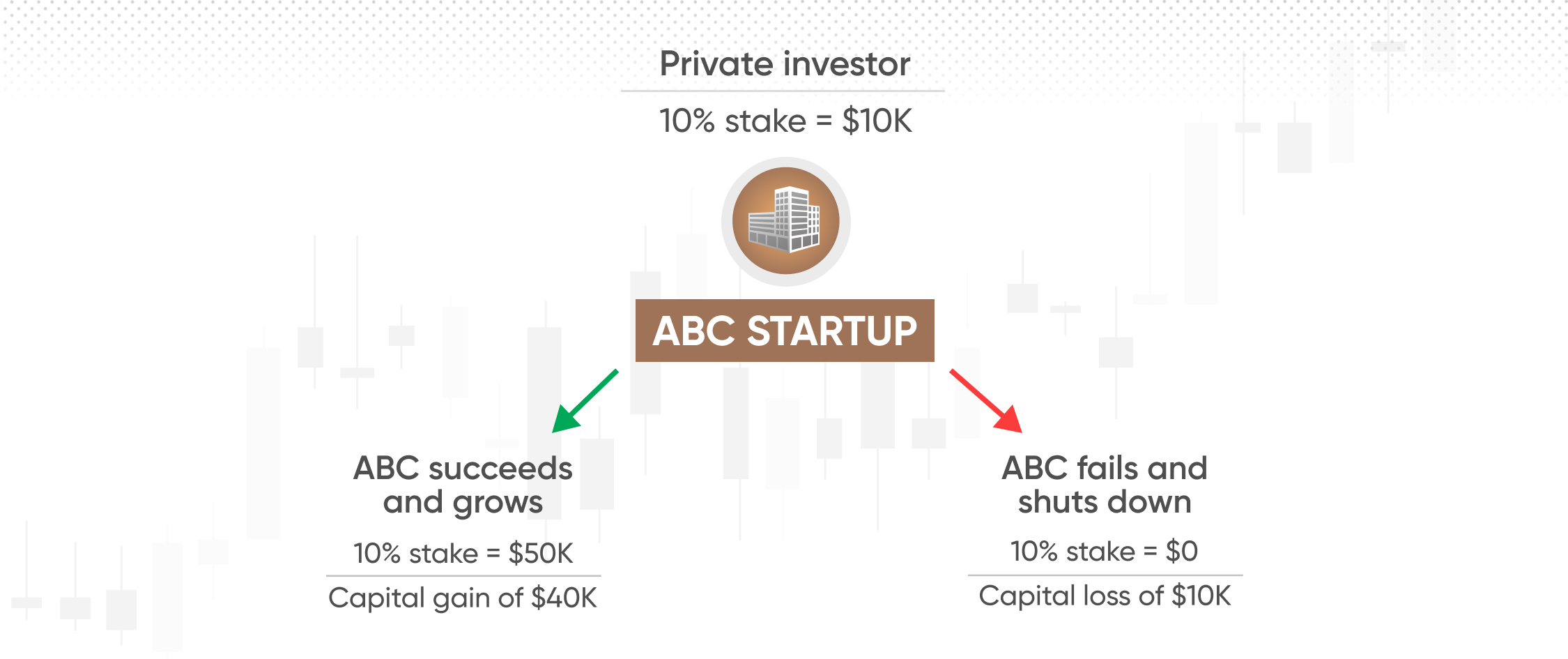What are equity stakes?

What are equity stakes?
Equity stakes represent ownership in a company. Investors who hold equity stakes have a say in how the company is run and, in some cases, even vote on important matters such as electing board members or making major business decisions.
Equity stakes can be held by individual and institutional investors, as well as other entities such as private equity firms or venture capital funds.
The value of an investor's equity stake in a company can go up or down depending on the company's financial performance and market conditions.
Key takeaways
-
The equity stake definition is that it is an ownership interest in a company, typically represented by shares of a stock.
-
Equity stakes can be acquired in various ways, such as through direct investment in a private company, by purchasing shares in a public company through the stock market, or by receiving equity as part of a compensation package or partnership agreement.
-
When an investor purchases equity stakes in a company, they become a shareholder.
-
The size of an individual's equity stake often determines their level of control over the company or asset.
-
The value of an investor's equity stake in a company can increase or decrease depending on the company's financial performance and market conditions.
Difference between equity stakes and other forms of investment
One of the main differences between equity stakes and other forms of investment is that equity represents ownership in a company, while debt represents a loan that must be repaid with interest. Debt investments, such as bonds, provide investors with a fixed income stream, while equity investments may offer the potential for capital gains and dividends.
Some other key differences include, but are not limited to:
-
Risk vs. reward: Equity stakes are generally considered to be riskier than some other forms of investment, such as bonds or savings accounts. This is because the value of an equity stake is tied to the performance of the underlying business, which can be volatile and subject to market fluctuations. In the meantime, equity investments may offer the potential for higher returns than bonds.
-
Control: When an investor owns an equity stake in a company, they may have a say in how the business is run and what decisions are made. This level of control is not typically available with other forms of investment, such as bonds or mutual funds.
-
Liquidity: Equity stakes may be less liquid than other forms of investment, particularly if the stake is in a private company. This means that it can be more difficult to sell an equity stake and realise the value of the investment.
Types of equity stakes
There are several types of equity stakes that investors may hold in a company.
Common stock: The most common type of equity stake. Common stock gives shareholders ownership rights in a company, which includes voting rights and dividends.
Preferred stock: Preferred stockholders receive a fixed dividend payment before common stockholders, and have priority over common stockholders in the event of liquidation. Preferred stock may also have other features such as a fixed dividend rate or the ability to be converted into common stock. However, it doesn’t grant investors voting rights.
Convertible preferred stock: This is a type of preferred stock that can be converted into common stock at a predetermined price and time. It gives investors the option to convert their preferred stock into common stock if the company's value increases.
Restricted stock: This is company stock that is granted to employees with certain restrictions or conditions, such as a vesting period or the requirement to meet certain performance targets before they are allowed to sell or transfer the shares.
Equity options: Equity options give employees the right to buy company shares at a predetermined price for a specific period of time. These are often used as a form of compensation or incentive for employees.
Equity warrants: Similar to options, equity warrants give investors the right to buy a company's stock at a predetermined price for a specific period of time. Warrants are usually issued as part of a financing round and can be a way for companies to raise capital.
Examples of equity stakes
Below are some examples of equity stakes:
-
Direct investment: An individual investor purchases equity stakes directly in a private company in exchange for ownership in the company.
-
Stock market investment: An investor buys shares in a public company through a stock exchange to gain an equity stake in the company.
-
Employee stock options: A company offers its employees equity stakes in the business through stock options or other compensation packages.
-
Venture capital investment: A venture capitalist provides funding to an early-stage startup in exchange for equity stakes in the company, allowing them to share in the company's potential future success.
-
Partnership agreement: In a partnership, each partner holds an equity stake in the business that reflects their ownership interest.
-
Joint ventures: In a joint venture, two companies form a new entity, and each company holds an equity stake in the new company proportional to their contribution.
Let’s take a look at a hypothetical real-life equity stake example in detail.
You want to invest in an ABC startup company that is looking to raise funds to expand its operations. The company offers you the opportunity to buy a 10% equity stake for $10,000. This means that you would own 10% of the company and would be entitled to 10% of the company's profits and assets.
Over the next few years, the company grows and becomes profitable. As a result, the value of your equity stake increases. After five years, your equity stake is worth $50,000. You decide to sell it, making a capital gain of $40,000 on your initial investment.
However, the startup may also fail and shut down its operations. In this case, the investor will lose all the money they invested.

If the company is doing well and decides to pay dividends to its shareholders, it will entitle you to a portion of the profits. For example, if ABC pays a dividend of $0.1 per share and you own 1,000 shares, you would receive a dividend payment of $100.
How to calculate equity stake
Firstly, you need to know how many outstanding shares the company has and how many shares you own. Then, you can calculate the equity stake using the following formula:
Equity Stake = (Number of Shares Owned / Total Number of Outstanding Shares) x 100%
For example, the company has 100,000 outstanding shares of common stock. You hold 1,000 shares. In this case, your equity stake is 1% (1,000 / 100,000 x 100).
Note that if there are multiple classes of stock, or if there are outstanding stock options or warrants that could potentially increase the number of outstanding shares, the calculation will be more complicated.
Importance of equity stakes
Understanding equity stakes is important as they represent ownership in a company and may provide potential financial benefits.
For businesses, offering equity stakes is one of the ways to raise capital, incentivise employees and align interests with shareholders. For investors, owning equity in a company may provide the potential for capital appreciation and dividend income. It may also offer voting rights, which allow shareholders to have a say in the company's management and direction.
Advantages and disadvantages of equity stakes
|
Potential advantages |
Potential disadvantages |
|
Potential for returns: Equity stakes may provide the potential for returns through capital appreciation and dividends. Ownership and control: Equity stakes provide ownership and sometimes voting rights, allowing shareholders to have a say in the company's management and direction. Capital raising: Equity stakes can be used as a way to raise capital for a business. |
Risk: Equity investments are inherently risky and can result in significant losses. Volatility: The value of equity investments can be highly volatile and may fluctuate based on company performance and market conditions. Dilution: Additional equity offerings can dilute the value of existing shares. |
Conclusion
In conclusion, equity stakes represent ownership in a company. The value of an investor's stake can increase or decrease depending on the company's financial performance and market conditions.
Keep in mind that equity stakes’ worth may be volatile. Investors and traders can stand to lose their money. If you are considering buying shares, make sure you do your own thorough research beforehand.
Remember that prices can go down as well as up, and never invest more money than you can afford to lose.
FAQs
What does equity stake mean?
Equity stake refers to an ownership interest in a company. It can be acquired by buying shares of stock or through the receipt of stock options, convertible debt, or other instruments.
Is equity and shares the same thing?
Equity and shares are related terms but are not the same thing.
Equity refers to the ownership of a company’s assets that belong to shareholders. Shares represent a unit of ownership in a company, they are issued by companies to shareholders and provide shareholders with certain rights and the ability to receive dividends.
Simply put, shares are a way that investors can acquire equity in a company.
Can equity stakes be diluted over time?
Equity stakes can be diluted over time. This happens when a company issues new shares of stock, reducing the percentage ownership that existing shareholders have in the company.